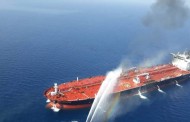Image via Shutterstock ©Bildagentur Zoonar
March 3, 2016 | gcaptain
By Jaquelyn Burton (Coeval)
The thing with Navigation Warnings is – are you sure that you have received all of the ones you might need? There are times when as an officer of the watch you receive a NAVTEX message that is corrupted or unreadable. When you have a message come in where the only thing that you can’t read about a firing exercise zone is it’s location.
The availability of internet on board ships is becoming more prevalent, making it possible to look up what a corrupted message says without taking the time to send in a report. But how many Mariners are taking the time to do so? Seldom do reports of corrupted messages get sent in or do they look up what the message should have said.On vessels that undergo vetting inspections (SIRE), there is a higher standard applied to the tracking and retention of navigation warnings and messages – Because of the competition factor that is propagated by the vetting process, between ships, companies and charterers. The SIRE Inspections are “One of the most significant safety initiatives introduced by OCIMF is the Ship Inspection Report Programme (SIRE). This programme was originally launched in 1993 to specifically address concerns about sub-standard shipping.”
While I was working on LNG tankers, it was common for us, not only to file any messages applicable to the area that we were in but to keep track of all of the messages in force for areas that we might transit on a later voyage. If our vessel hadn’t been in a navigational area for more than a month, we would also request all of the enforce nav-area warnings for that area. If you don’t know Navarea Warnings are only broadcast over SafetyNET for the ones that are cancelled or come into force in the prior 42 days – so if you are entering an area and receiving messages you might not be receiving all of the messages in force for that area. You could be running into danger without knowing it.
Additionally, some messages such as the U.K. Notice To Mariners do not contain the same warnings and corrections as the U.S. Notice To Mariners. One instance was that a vessel was coming into anchor off of Boston narrowly missed anchoring on a pipeline. Their charts were up to date and fully corrected, but they were using charts from the UKHO and not the U.S. NOAA – the pipeline did not appear on the UK version of the chart for that area. You might be surprised, but not all nations communicate all of the nav-warnings between each other – especially warnings about their territorial waters.
The problem with the way Nav Messages are relayed now is that in the case of NAVTEX multiple copies messages of the same warning can be received from different stations with different warning numbers – so it can be difficult to track which messages you have received already and which ones are still in force. Then you have the problem of finding out if the message is relevant to your voyage. If you miss a message, you could well find your vessel in a firing exercise or other similar dangerous circumstance.
Is the problem with tracking messages a problem of the way the system is currently set up? Could it be as simple as training navigators in a systematic approach to monitoring and maintaining a message log – as are being used on vetted vessels? Or is it a problem with the system itself? With the implementation of ECDIS and all of the requirements that have come along with it – is it time to change the way warnings are broadcast? Time to make it apparent when you haven’t received a NAVTEX or an EGC (Enhanced Group Call) Message? Would it be better if the SafetyNet had push notifications based on your route and heading?
The use of “smart phones” for navigation has changed how we drive and route our cars. I use Waze a lot when I’m driving; it can tell me if there is an accident up ahead, if there is a pot hole in the road ahead, if the road is closed, even if there is fog up ahead.
Wouldn’t it be helpful if the same type of system was implemented on the seas? Where an updated database would be queried, and it would say “light on buoy out ahead,” where vessels could quickly report problems or what they see in real time without having to fill out forms and submit them officially – Waiting for a response.
It would be so helpful if all of the navigation and safety warning data of all the maritime nations could be queried with your vessels route and the desired cross track. Letting you obtain exactly the navigational warning information you need, with checks that it is from a complete database.
It’s not that there is a lack of technology, it’s simply that there is a lack in utilizing what is available. Some regulations restrict what our global Mariners can do with regards to the transfer of live information. Our land-lubber friends avoid congestion on the Capital Beltway using downloadable applications. Meanwhile, Mariners rely on Vessel Traffic Service (VTS), Automatic Identification System (AIS), and Traffic Separation Schemes (TSS) where they are available.
Further training mariners on how to more effectively track and use existing systems could solve some of the problems that exist in making sure that warnings and safety information doesn’t slip through the nets. We are fast approaching fifty years since putting a man on the moon, yet we still cannot send safety messages to our vessels on Earth that aren’t corrupted. With that said, there is a lot that could be done with the technology that surrounds us every day, with just a simple change in policy or application, that would modernize our industry.
By Jaquelyn Burton. Find out more about us at http://Coeval.us training for the #modernmariner.
Related Articles
eLoran Sparks Debate In Washington – Is It Truly Important?
Europe Calls Time on Ship Navigation Scheme Despite Risks at Sea
Top 10 iPhone Apps When You Are Adrift At Sea!
Recommended For You
The Box: How the Shipping Container Made the World Smaller
Celebrate the U.S. Navy’s 240th Birthday with These Awesome Ship Photos of the Day
Asia-Europe Container Freight Rates Drops 28 Percent
Aircraft Carrier Hit by Two Atomic Bombs and Scuttled Decades Ago Still ‘Amazingly Intact’















